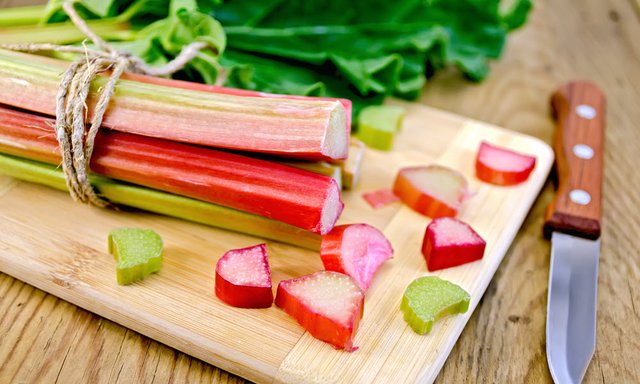
What is rhubarb?
Rhubarb is a perennial plant with short thick rhizomes, pink-green stems, and triangular leaves. It was originally part of medicine, not cuisine.
Rhubarb grows throughout the spring and summer, but the best harvest time is between April and June. You can consume not only characteristic, bright pink stems but also rhubarb flowers. However, this does not apply to the leaves that may be poisonous.
Rhubarb has an interesting, slightly tart taste, which is why it works so well in desserts, which can be accompanied by sweet fruit or sweet crumble.
Health-promoting properties of rhubarb
Relieves inflammation
Chinese medicine practitioners believe that rhubarb helps maintain beautiful skin, has a positive effect on eyesight, and supports anti-cancer protection.
One study in the Chinese city of Guangzhou showed that rhubarb powder alleviated inflammation and also improved the prognosis of patients suffering from systemic inflammatory response syndrome (SIRS). This is a very serious condition, sometimes resulting from infection or injury.
In turn, a study published in the Pakistan Journal of Pharmaceutical Sciences revealed that rhubarb extract accelerated the healing of cut wounds. All thanks to inhibiting bacterial growth and alleviating inflammation.
Takes care of strong bones
Rhubarb contains a solid dose of vitamin K, which is an important component of bone formation and metabolism. A review published in Nutrition in Clinical Practice reports that this vitamin has a positive effect on bone mineral density and reduces the risk of fractures. So it is essential to prevent the development of osteoporosis.
Facilitates digestion …
A study of the Chinese Burn Treatment Center at Tisco General Hospital looked at the effects of rhubarb on abdominal discomfort in patients staying there. The focus was primarily on relieving flatulence and discomfort, as well as regulating bowel movements.
Rhubarb has been observed to increase the secretion of gastrointestinal hormones, ensuring proper muscle contraction. Thanks to this, the contents of the gastrointestinal tract are mixed, which protects the intestinal walls from damage.
… and regulates bowel movement
Rhubarb has slightly laxative properties, thanks to which it helps to get rid of constipation. Tinctures, extracts, and rhubarb powders are also often used for diarrhea.
Mitigating toilet problems is also important because of the risk of hemorrhoids. This unpleasant ailment can be the result of both chronic constipation and diarrhea.
Fights the accumulation of free radicals
Rhubarb also contains many antioxidants, such as, for example, flavonoid quercetin.
A study of rhubarb seeds by the Northwest Institute of Plateau Biology at the Chinese Academy of Sciences focused on their antioxidant potential. They found, among others: epicatechin, myricetin, hyperoside, quercitrin, and quercetin. They are all-powerful antioxidants that help eliminate free radicals.
Helps to promote the well-being of the brain
In an in vitro study, the results of which were published in Molecular Medicine Reports, the effect of rhubarb extracts at various concentrations on radiation-damaged neurons was assessed. It was found that this agent clearly reduced brain inflammation caused by radiation. Rhubarb protective effect against oxidative stress can be potentially useful in the fight against e.g. Alzheimer's disease, stroke, or ALS.
Nutritional values
In addition to antioxidants and fiber, rhubarb also contains many other ingredients that are important for our health.
It is estimated that 1 cup (about 122 g) of diced raw rhubarb contains:
26 calories,
5,5 g carbohydrates,
1,1 g protein,
0,2 g fat,
2,2 g fiber,
35,7 µg vitamin K (45% recommended daily intake),
9,8 mg vitamin C (16%),
0,2 mg manganese (12%),
105 mg calcium (10%),
351 mg potassium (10%),
14,6 mg magnesium (4%).
Low calories, many nutrients.
How to use rhubarb
The sour flavor of rhubarb makes it perfect combined with sweet additives. It is also great in sauces and salads. Peeling rhubarb is not necessary, but it should be thoroughly washed and the ends trimmed. Although it can be eaten raw, heat treatment is recommended to reduce oxalate acid concentration.
Rhubarb is best kept in a box/bag in the fridge for a maximum of 5 days. It can also be frozen and stored for up to a year. This is important because fresh rhubarb breaks down rather quickly.
Side effects and precautions
Please note that rhubarb leaves are unsafe. Their consumption can cause food poisoning, resulting in gastrointestinal problems. Prolonged consumption of rhubarb leaves can cause more serious health problems due to the presence of oxalic acid.
The use of rhubarb and its supplements/products should be consulted by a doctor in case of pregnancy, kidney, or liver disease.
Rhubarb products are likely to interact with diuretics and blood thinners. If you use them, consult your doctor.
Read more at healthyasbirch.com